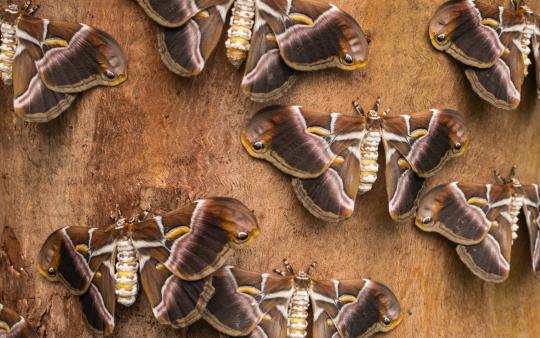Fluttering around street lights and hovering over candle flames, moths are sometimes thought of as the butterfly’s drab cousin. But with evocative names like Graceful Ghost moth, Shaggy-spotted Wockia, and Elegant Tailed Slug moth, there is more to them than meets the eye!
So many moths!
Believe it or not there are ten times more moths than butterflies in the world! And in North America alone, there are more than 12,000 species. Moths come in a wonderful variety of sizes, shapes and colours. From very large, like the Atlas moth with a wingspan of almost a foot, to the weirdly wonderful, like the beautiful Wood Nymph that looks like bird poop (on purpose!). And forget the idea that moths are only brown: just take a look at the Rosy Maple moth with hues of red, yellow, black, and gold, or the magnificent white-lined Sphinx moth that resembles a hummingbird with rose-coloured hind wings and beautiful brushes of white!

Giant Silkworm moth
But what do moths DO?
Even though they don’t have a nose, moths are good at sniffing! They use their feathery antennae to detect even the faintest of odours. A Giant Silkworm moth (shown above) can smell a female from over 11 kilometres away (talk about having a nose for news!). And like bees, they are amazing pollinators. Their plump, hairy bodies help them pick up and transfer pollen from any flower they land on! They especially love white, fragrant flowers that bloom at night, such as the yucca plant or moonflower.
Moth or butterfly?
|
|
MOTH |
BUTTERFLY |
|---|---|---|
|
Wings |
Tend to hold wings outstretched |
Tend to fold their wings together |
|
Behaviour |
Nocturnal (active at night) |
Diurnal (active during the day) |
|
Cocoon/Chrysalis |
Caterpillars make a silken cocoon around their body |
Caterpillars make a hard shell chrysalis that emerges from inside of their body |
|
Body |
Thicker abdomen |
Thinner abdomen |
|
Antennae |
Thicker, feathery antennae |
Thinner club-shaped antennae |
Make a magical moth potion
This special recipe will attract both moths and butterflies The ingredients might seem a bit strange but moths and butterflies love fermented fruit, tree sap, and even urine (optional!).
Beware! This recipe may also attract yellow jackets and other stinging insects!
Ingredients
- 1 pound sugar
- 1 or 2 cans stale beer (optional)
- 3 mashed overripe banana
- 1 cup of molasses or syrup
- 1 cup of fruit juice
- 1 shot of rum (optional)
Instructions
Mix all the ingredients thoroughly and use a brush to paint on trees, rocks, fence posts, or stumps. You can even soak a sponge in this mixture and hang it from a tree branch. Keep visiting your spot to see what splendid lepidopteran sips your magic potion!
Make a moth lantern
Moths use distant light to orient themselves at night. That’s why you can always attract them with a bright light.
Any type of light will attract moths! Just leave a porch light on and wait and see who flutters by. If you are in a field or forest, you can use battery-operated lights or a flashlight. Black lights are often used by entomologists and they give off light in the color spectrum that moths find hard to resist. You can buy this online at a reasonable price.
Or hang a white sheet on a clothes line and shine a bright light on it. Moths like to rest and the colour white makes your visitor easy to spot. Have a camera ready so you can take pictures. Want to know what kind is hanging around? Visit Butterflies and Moths of North America to get you started.









